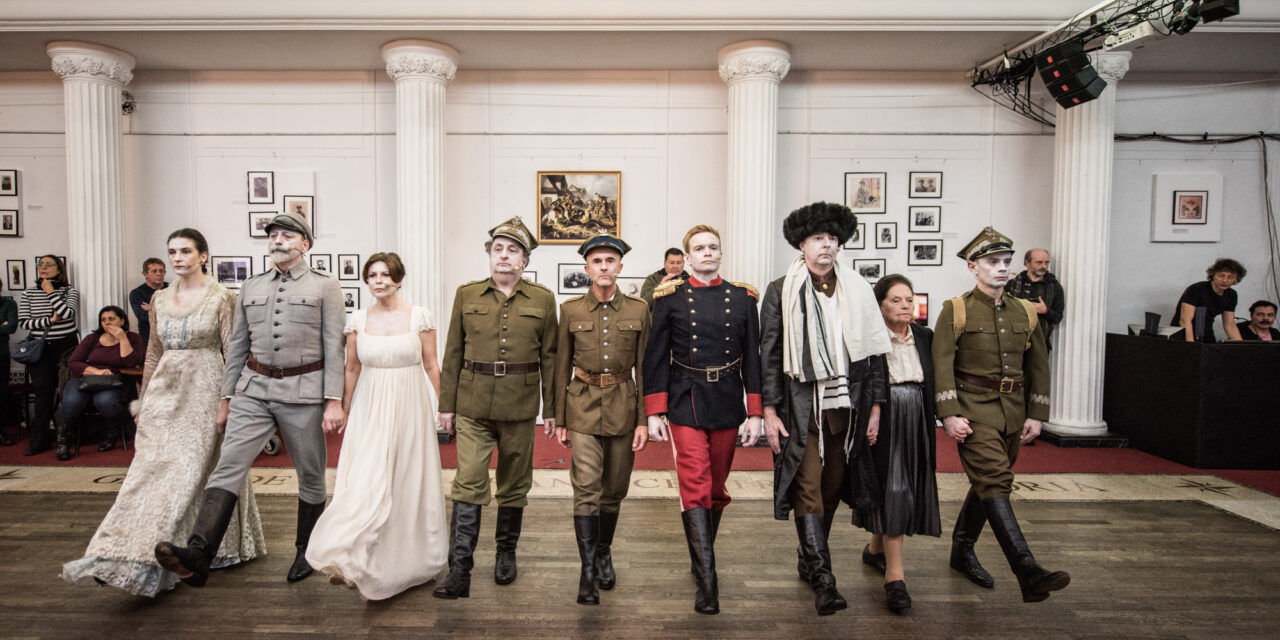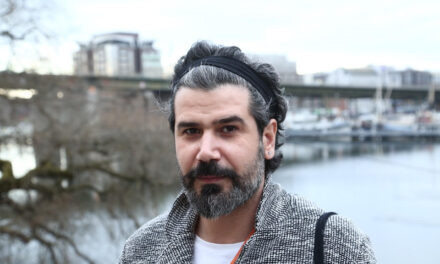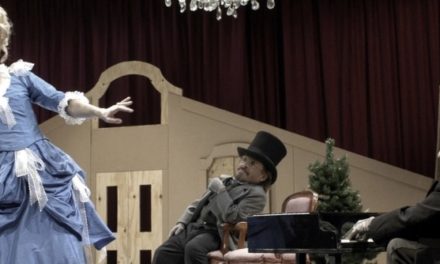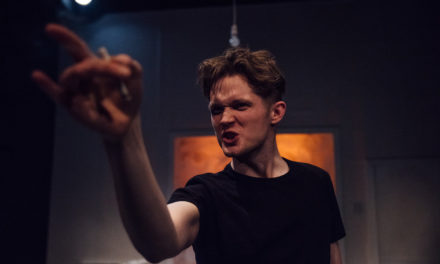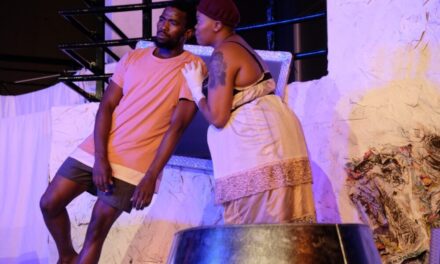Maja Kleczewska’s and Łukasz Chotkowski’s Berek is like a dive into a dark spot of history, a confrontation with facts that are not so much denied as viewed as irrelevant in the Polish historical narrative. Berek is not a play about the need to reclaim memory — it focuses on events and people that nobody really wanted to remember. Starting from the figure of Berek Joselewicz, an officer of the Polish Legions who died in the battle of Kock fought against the Austrians in 1805, the creators zoom in on the Jews who joined the struggle for Polish independence — from the Kościuszko Uprising to World War II to the Warsaw Ghetto Uprising. Kleczewska and Chotkowski, however, do not deploy a perspective of commemorative melancholy, they do not seek confrontation or attack anyone as they did in Dybuk (Dybbuk) and Malowany ptak (The Painted Bird). Instead, they set up an alternative pantheon of characters who should be hailed with the shout “Glory to the heroes!,” although those most eager to use this exclamation would be at least dismayed at the Polish heroes of Berek.
The bulk of the script is made up of documentary material, including speeches of Jewish military leaders; rabbis’ calls on Jews to stand up for Polish independence; the Roll Call of the Fallen on April 19, 2013; Jewish Legionnaires’ 1915 appeal to Jewish youth; Yitzhak Zuckerman’s 1944 appeal to the defenders of the Warsaw Ghetto; Polish and Jewish patriotic songs; excerpts from Zygmunt Krasiński’s Undivine Comedy and Stanisław Wyspiański’s The Return of Odysseus. Chotkowski weaves them together to compose a score with no coherent narrative or division into roles and characters. The viewer has no recourse to the impulses kick-starting individual scenes.
The show begins by the cloak area. In a calm voice fit for a museum guide, Barbara Szeliga, dressed in military uniform, speaks about Berek Joselewicz describing his background, education and how he got into the army. Then she goes to the main space, which is bright, white-walled and complete with columns. The main space and lobby are decorated with replica paintings, photos of the Polish Army’s Jewish units, portraits of members of the Jewish Combat Organization and Polish Army rabbis. Stands with military uniforms and prayer shawls are placed in two recesses. The floor is covered with red carpet and in the center of the room is a large wooden rectangle with a stone frame, which brings to mind a museum, art gallery, or memorial hall setting.
The actors (Marcin Błaszak, Henryk Rajfer, Rafał Rutowicz, Piotr Sierecki, Jerzy Walczak and Marek Węglarski) and actresses (Ewa Dąbrowska, Kaya Kołodziejczyk, Joanna Przybyłowska, Barbara Szeliga and Teresa Wrońska ) gather in front of Henryk Pillati’s painting The Death of Berek Joselewicz at Kock, while Wanda Siemaszko tells them about the circumstances of the event depicted on the canvas. First, audience members hesitatingly approach to have a close look at the painting and then gradually start moving more freely around the room, following the actors, sitting down on the floor and by the columns.
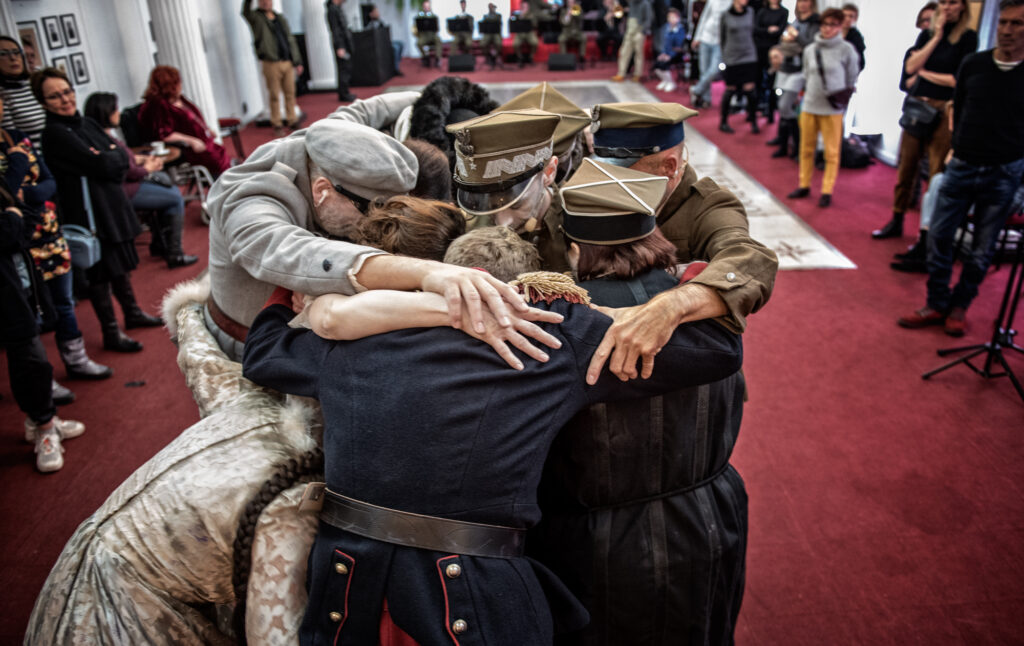
Berek. Directed by Maja Kleczewska. The Ester Rachel and Ida Kaminska Jewish Theater, Warsaw Photo by Magda Hueckel.
From the very start, Kleczewska does not let the audience become attached to simple interpretations and keeps on leading them astray — the suggestion that the play is set in a museum is quickly undermined and Joselewicz ceases to be the central figure. The director makes sure that nothing that happens in Berek can be easily defined ‒ everything is fluid, elusive, unpindownable: the setting, the status of the actors, the meaning of particular scenes. The men are dressed in different era uniforms, the women in ball gowns, almost everyone has whitewashed faces. The story of the Jewish fighting spirit in the Polish army is built from raw facts interspersed with patriotic songs. The words “Jewish” and “Jews” crop up alongside “patriotism,” “freedom,” “independence,” “homeland” and “duty.” The whole spectrum of examples of Jewish military involvement proves it has not been a marginal or occasional phenomenon but an important and integral part of Polish history. What sets Jewish culture apart is Yiddish. After singing the WWI song Piechota (The Gray Infantry) in Polish, the actors break into The Song of the Warsaw Ghetto Fighters in Yiddish. The most striking songs, however, are the Yiddish translations of Rota and Poland Is Not Yet Lost, the latter emotionally sung by Wanda Siemaszko, standing on the pavement outside the gallery together with Jerzy Walczak. The audience inside and outside the gallery listens to the Yiddish version of the Polish anthem.
The space, designed by Zbigniew Libera, is central in Berek. The show is performed in the concert hall at 63 Nowy Świat Street, where it intersects with Świętokrzyska Street, in the heart of Warsaw. There is no division between the stage and the audience. Sitting along one wall are brass band musicians, with a small platform with a piano farther down. The actors move among the audience and some spectators choose who they want to listen to (Walczak delivers a monologue fromThe Return of Odysseus, while Marek Węglarski recounts Holocaust stories in the lobby).
The high curtainless windows of the longer wall overlook Świętokrzyska Street. Performed in full light, the show attracts the attention of passers-by, who stop in their tracks to take photos and videos, thus becoming a second audience and a vital part of the performance. The procession of uniformed men, pale women in ball gowns and a Jew in a black coat, prayer shawl and Hasidic hat is an intrusion into the monotonous street life. It bewilders, intrigues, disturbs. It seems that commemorative rituals, repeated for ages, in secret, by a group of the dead, have now been suddenly exposed, brought into view.
While the Jewish fighting spirit is put on a par with the Polish spirit of independence, it seems somewhat inappropriate in the story of the Holocaust and its victims. At the end of the show, Jerzy Walczak recites the open letter that Simcha Kazik Rotem, the last survivor of the Warsaw Ghetto Uprising, wrote to Andrzej Duda in 2018. In it, Rotem expresses his astonishment at the historical policy endorsed by the Polish President and objects to putting the suffering of Poles and that of Jews during the Second World War on an equal footing:
“I’ve read the speech you delivered last week at the ceremony marking the 75th anniversary of the Warsaw Ghetto Uprising. I became very frustrated, disappointed and even amazed by your systematic disregard of the fundamental difference between the suffering of the Polish nation after Poland was seized by Nazi Germany, which I do not disparage, and the methodical genocide of my brothers and sisters, Poland’s Jewish citizens, by the Nazi-German extermination machine, ignoring the fact this extermination machine had many Polish accomplices.”

Berek. Directed by Maja Kleczewska. The Ester Rachel and Ida Kaminska Jewish Theater, Warsaw Photo by Magda Hueckel.
He ends his letter with a rhetorical question:
“Do you, the leader of the Polish nation, want to be an accomplice in transforming this unconceivable disregard into the ‘new historical truth’ passed on from generation to generation?”
Standing in front of the audience and looking at the floor, Walczak speaks with a strong and firm voice. The phrase “I, Symcha Kazik Rotem,” which keeps recurring in the letter, has a near-accusatory ring. After the speech, the actors pin a set of medals to his uniform, give him a white-and-red sash, wrap him in a Polish flag and, after hoisting him on their shoulders like a hero, repeatedly traverse the gallery. But Walczak is not triumphant. He sits still with a blank stare. The actors’ behavior seems awkward, misplaced, thoughtless.
Kleczewska has mostly built her production around actors’ movement. In a bravura feat, choreographer Kaya Kołodziejczyk uses simple routines and precise gestures to lead the actors from dispersion to collective scenes. In one scene, Kołodziejczyk throws herself among the actors walking in a column or cuts in front of them, moving in counterpoint to their marching steps. She tends to stay on the periphery, sometimes joining in for group routines, then breaking away and surrendering to the logic of her own movement. In a scene from The Return of Odysseus, Kołodziejczyk leaves the gallery wearing a white puffer jacket, pants and a hat. She plays one of the sirens encountered by Odysseus ‒ restless and lost, she runs among the people passing by, crosses the street, takes a peek into the courtyard, climbs walls, confuses passers-by. The movement in Berek is compatible, in a non-straightforward manner, with the amazing score by Cezary Duchnowski, who created a dark backdrop for the marching pieces by disrupting familiar tunes, stretching out sounds, changing keys, emphasizing the orchestral aspect. His arrangements are disturbing and packed with so much pathos and suspense that almost every scene seems like a climax.
References to Kantor’s Theatre of Death are strongly in evidence. The director sets up a kind of séance on the cusp of a “meeting between the living and the dead,” which Kantor prefigured in his prologue to I Shall Never Return, while The Gray Infantry evokes associations with Wielopole, Wielopole. Not insignificant is also the presence of actor Jerzy Walczak, with whom Kleczewska has worked since starting her collaboration with the Jewish Theater in Warsaw. In the Dybbuk prologue, Walczak delivered a Kantor monologue from I Shall Never Return, and then reprised it in The Painted Bird, where he portrayed Jerzy Kosiński. In one scene, the actor gives Odysseus’ homecoming monologue from Act Three of the Wyspiański drama. The same monologue was read in I Shall Never Return by Kantor, who sat at the table with Odysseus. Stands in front of one of the windows and looking at the people passing by, Walczak speaks of his disappointment at his homecoming, lost youth, guilt, contrition and lack of forgiveness. He is back in his homeland that is intent on selectively remembering its past. He speaks slowly, with sadness in his voice, as if his Odysseus has accepted his plight. He is not disturbed by the surrounding confusion or the fact that the audience behind the glass cannot hear him. Kantor used elements of History (with a capital H) to build an autobiographical story. Kleczewska opens Berek’s narrative to a biographical theme so that the story of the past becomes intimate and personal for a while, and thus closer to the audience ‒ in the finale of the show the director gives the floor to charismatic Henryk Rajfer. Standing in the middle of the room, the actor speaks of his Warsaw childhood, his Jewish family and its life after WWII, the life of Jews in communist Poland, of 1968 and his mother’s funeral where he met his father, who, as it turned out, used to be a private in the Polish army. As the story unfolds, Kołodziejczyk comes among the audience urging them to follow her to the wall covered with photos, which also features Szymon Rajfer’s military ID card. Beginning with the story of a saber-wielding, horse-riding Romantic hero, Berek ends with one about an ordinary person. The consistency with which Polish history has managed to remain silent about such people is all the more surprising.
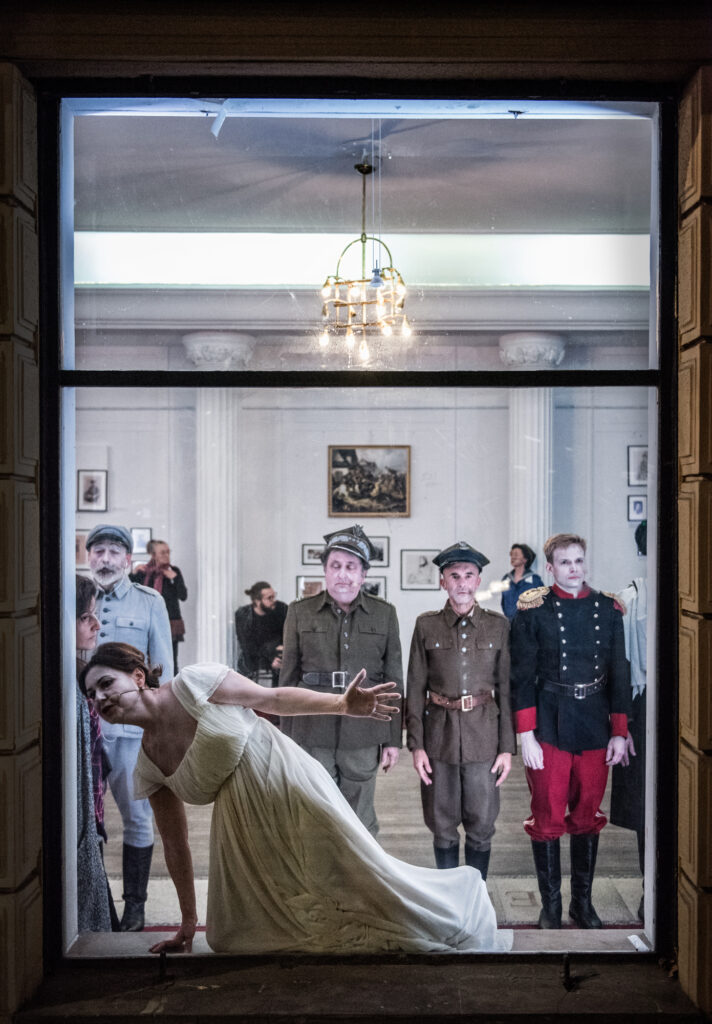
Berek. Directed by Maja Kleczewska. The Ester Rachel and Ida Kaminska Jewish Theater, Warsaw Photo by Magda Hueckel.
Berek captivates with the extraordinary intensity of the actors’ presence. The actors are physically close but look away as if they do not see anyone, focused on the set and their own singing. The small space makes it difficult to keep the distance — sometimes the audience has to move out of the actors’ way. At another point, the actors are very close to the audience, staring deeply into their eyes. They take some audience members by their hands and form a column moving to the beat of the patriotic anthem Rota (The Oath). Berek is more than just a play. It is an event that invades the city in order to uncompromisingly violate, irritate and disrupt it. It is short but extremely intense, performed with plenty of tension. And despite the fact that there is so much happening at the same time in the multiple dimensions of text, movement, music and situation, it is never distracting, the audience is utterly riveted.
Berek
Directed by Maja Kleczewska; dramaturgy by Łukasz Chotkowski; adapted by Łukasz Chotkowski and Maja Kleczewska; stage design by Zbigniew Libera; costumes by Konrad Parol; music by Cezary Duchnowski; choreography by Kaya Kołodziejczyk; vocal training by Teresa Wrońska; premiered on December 7, 2019.
This article was originally published in Polish by Didaskalia. Theater Journal 2020, no. 156. It was translated into English by Didaskalia and TheTheatreTimes.com and reposted with permission. The translation was supported by Polonia Aid Foundation Trust.
Didaskalia is now an open-access journal. The frequency remains unchanged and they will continue to appear bimonthly.
This post was written by the author in their personal capacity.The opinions expressed in this article are the author’s own and do not reflect the view of The Theatre Times, their staff or collaborators.
This post was written by Marta Bryś.
The views expressed here belong to the author and do not necessarily reflect our views and opinions.

